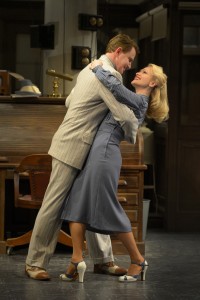La Jolla His Girl Friday Looks Great Despite Script Clunks
What a hoot it might be to see the La Jolla Playhouse do The Front Page, Ben Hecht and Charles MacArthur’s delicious newspaper valentine, with the company presently assembled for something called His Girl Friday.
There would have to be some slight tweaking of the décor to move a decade back from 1939 and a couple of important casting fixes. Otherwise, though, this large, deep and fully engaged troupe, guided by the buoyant direction of Christopher Ashley, might well deliver a richly satisfying version of an American classic. Instead, we are offered this pastiche assembled by John Guare from the carcass of the original, with selected highlights from the 1939 Howard Hawkes film (the source of this dreadful title) and a choking dose of politics.
Guare is an OK playwright (House of Blue Leaves, Six Degrees of Separation) who reveals here little sense of how to handle the pungent period cynicism of this fantasy farce. Hecht and MacArthur, themselves former newspaperman, wanted to spotlight the vanishing species of what they called, “the lusty, hoodlumesque, half drunken caballero” who were the dream heroes of popular newspaper legend. And they dropped these guys into the criminal court pressroom of 1928 Chicago because that city, with eight competing daily newspapers, was “…a sort of journalistic Yellowstone Park offering haven to a last herd of fantastic bravos that one roamed the newspaper offices of the country.”
The plot – ace reporter being dragged away from the paper biz by a fiancé determined to remake him respectable, just as the big story breaks – could have been used with any random tale lifted from any week’s court calendar. The story chosen – accused cop-killer escapes jail on the eve of his hanging thus periling the reelection chances of mayor and sheriff – offered plenty of action twists and abundant opportunity to wallow in the low-life so delicious to audiences of that (or really any) period.
Guare found some connections with the present and he couldn’t help illustrate them with breaking news from the past. Thus the original vague references to Bolsheviks and anarchists becomes a wriggling mess of Hitler, Stalin, Roosevelt, Lindbergh, Chamberlain, Poland and Jewish oppression with an occasional “terrorist” thrown in to underline present parallels. All of this needs illumination (there’s even an explainer essay in the show program) so, there goes a lot of priceless farce timing. Switch the star reporter to female and make her the ex-wife of the tough editor (Hawkes’ big alteration), then tread a delicate tiptoe through racial and gender stereotyping of three separate eras and you have this clunky script, a mule’s load harnessed to a racehorse.
In truth, the film version worked pretty well, but that was mainly because Hawkes had two major stars – Cary Grant as the editor, Rosalind Russell as the reporter – to carry the load. It’s certainly no fault of Jenn Lyon and Douglas Sills that they ain’t movie stars, just excellent actors with the chops to make vivid characters burst through the crust of clunk. Sills is more boisterous than calculating as the editor, though his powers of monomaniacal focus are chilling. Lyon struts stylishly as the ace reporter, justifying the space she’s won in this man’s world with her quick uptake and undauntable spirit.
Stereotypes abound in the supporting cast. William Hill is the standard crooked and dumb sheriff, Mary Beth Peil does a fine Margaret Dumont as the mother-in-law, George McDaniel is exactly what’s needed as a slimeball mayor, Patrick Kerr does nebbish victim as the escaped killer and Bethany Anne Lind resists pathos in a non-pc nailing of what Hecht and MacArthur wanted in a cheap whore. Donald Sage Mackay plays the sad role of the reporter’s fastidious fiancé probably more prissily than necessary. And Jonathan McMurtry, as a doddering clergyman, avoids stealing the show only by sheer personal professional control. There are a host of others, many fixtures on the local stage, who all serve brilliantly as part of the show’s glorious, gritty texture.
The delicious Robert Brill set, a cold, institutional nightmare, is at the core of this atmosphere. Paul Tazewell’s costumes are pretty well beyond cavil. David Lander makes the lighting fit in every case. And, to be fair, there are moments when even this script works. “She doesn’t know Chicago!” trills the son of the dowager when she’s kidnapped by gangsters. “She will after this,” rasps the editor, dismissively. Now that’s a line in keeping with the ancestry of this script and worthy of the flavor in this production.
[box] Continues at 7:30 p.m. Tuesdays and Wednesdays; 8 p.m. Thursdays-Saturdays; 2 p.m. Saturdays and Sundays; and 7 p.m. Sundays trough June 30, 2013.[/box]

Welton Jones has been following entertainment and the arts around for years, writing about them. Thirty-five of those years were spent at the UNION-TRIBUNE, the last decade was with SANDIEGO.COM.




Mr. Jones hit it on the head. A great stage set does not a great play make! “His Girl Friday” was more a “Monday” than a great “Friday.” For a play written in 2003, it was dated, tired, and tragically out of touch. Yes, an actual “The Front Page” would have been a better choice!